Photo: Earl Gardner
Who: Philadelphia Union at New York City FC
What: 2015 regular season game
Where: Yankee Stadium
When: Thursday, April 16 at 7 pm
Watch: TCN, MLS Live, Direct Kick
Whistle: Baldomero Toledo; Linesmen: Kermit Quisenberry, CJ Morgante; Fourth Official: Edvin Jurisevic
Such is the nature of this 2015 season that Philadelphia Union only have half a week to enjoy their first win of the season before they have to, quite literally, do it all over again.
Vincent Nogueira’s stoppage time winner was a fitting end to a match that featured two managers making the most of scarce resources. The Union midfield rarely saw the ball, but when they did it was Nogueira who orchestrated the counterattacks, with Zach Pfeffer pushing into the box as a late runner. So while it was fitting that the best player on the pitch scored the winner, it was ironic that he only did so because Pfeffer cramped up after 84 minutes of making that exact same run.
What made Saturday’s match so interesting is that both teams are at the same point in their development: The players know what they should be doing, but they also seem a bit like they can’t figure out how to do it better.
New York’s far-from-finest
With an extra week off, it would not have been too surprising to see NYCFC come out with an improved shape and quicker ball movement. But alas, the first half of the match proved that the issue is likely not with Jason Kreis’ ability to communicate his tactics but instead with the ears receiving said communication.
Jason Hernandez and an out-of-position Chris Wingert are never going to look svelte on the ball, but even Kreis must be surprised at how flustered his central defenders get under the lightest pressure. The anxiety comes out less in poor passing than it does in an almost tangible desire to get rid of the ball as quickly as possible. Hernandez, in particular, metronomically looked to his fullback, looked back across to Wingert, then dinked a ball up to Adam Nemec. Wingert was hardly better, though he had more midfield support and kept the ball on the ground.
The result was a gloriously deceiving passing chart that shows how both players rarely gave the ball away but hides just how little they did with it.
A more informative graphic highlights Philadelphia’s first half defense. Seven interceptions in the opposition half is certainly more likely when you cede possession, but still… that is poor decision-making from NYCFC. Also note the ring-of-firesque line of recoveries just inside the Union defensive half as another indication of just New York’s cluelessness going forward.
Philly figures it out
The defensive shape, that is.
For the past two matches, Jim Curtin has put together the type of modern, pressing defense that can stifle MLS’s athletic, oft-untechnical sides. Kansas City under Peter Vermes has created space as well as any team in the league, but against the Union they found gaps up the gut and Philly consistently tracked back up the flanks. The first half against New York was even more impressive, with Michael Lahoud taking a leadership role pressing smartly behind Zach Pfeffer and Vincent Nogueira. New York’s midfielders had to retreat between the fullbacks to start the offense, and even then Philly’s defense consistently pressed with a plan rather than acting as individuals.
Jim Curtin has taken a lot of criticism in 2015. Give him the praise he deserves for devising a game plan and making it work without his top playmaker or striker (and with the man he expected to be in defensive midfield shoring up the back line).
Kreis shows his value
But fun as it was to watch NYC struggle in the first half, it was equally impressive to see Jason Kreis make such effective adjustments in the second. One can (and should) question why Kreis insists on deploying Adam Nemec as a soccer player, when the obvious move would have been to pull Nemec for Khiry Shelton at halftime. Instead, Velasquez made way, leaving the right wing naked.
It was a decision that impresses on two levels. First, Nemec was awful in the first half and it would have been easy to simply decide that taking him off the field would, almost by default, make New York a better side. But Nemec, for all his faults, was the only thing Kreis had capable of pinning Philadelphia’s defense deep. Shelton’s running could move players around, but it’s the back-to-goal play that keeps the central defenders far enough from the midfield for Mix Diskerud, Ned Grabavoy, and — most importantly — David Villa to slip inside with enough space to operate. Nemec isn’t much, but he is a big body.
Second, hauling off Velasquez was a well-calculated, low risk gamble. Jason Kreis doesn’t need to read PSP (and he most definitely does not) to understand that Andrew Wenger has been winding down quickly in the latter halves of matches. By dropping the defensively useless Shelton onto that side of the pitch, Kreis was betting that Josh Williams would have little trouble wrapping up the Union’s struggling winger. And, unfortunately, he was right.
Thus, Kreis got the best of both worlds: He added a more dynamic attacker to the match and sacrificed little defensively.
But the substitution was far from the most useful halftime change NYC made. It is fairly clear that somebody pulled Hernandez aside at halftime and said, “Every ball you play in the air is ten wind sprints after the match.” Hernandez played the ball faster in the second forty-five, with an emphasis on getting the ball back to the left as quickly as possible. Without a right midfielder, New York had no choice but to attack up the left, and that they did more effectively and efficiently than anything they did in the first half. The key was getting the ball to the feet of the midfielders fast enough to avoid the Union’s three-quarter field trap. Diskerud peeled over to the left channel, pushing Grabavoy higher with the end goal of getting the ball to Villa’s feet within 25 yards of goal.
Villa’s first half was far from ineffective, as he was simply too far from goal when he received the ball to immediately threaten John McCarthy. By overloading the left side of the pitch, NYC was able to get Villa involved on the edge of the box, where he quickly made his presence felt.
Implications for Thursday
Jim Curtin noted that the small Yankee Stadium pitch may end up being a boon for the visitors. New York struggled to find space at PPL Park, and they effectively abandoned the right side of the field (strategically abandoned, of course, as evidenced by Josh Williams sneaking into the box to set up Villa’s goal).
Philly should be able to control the midfield space once more, even if Curtin opts to start with Cristian Maidana over the energetic Pfeffer. The more important question is whether the Union can keep the NYC midfield honest by involving Andrew Wenger (or whoever plays on the left) in the counterattack.
In the few instances that Wenger was involved, he showed his effectiveness. Collecting a loose ball in his own half, Wenger started the break that released Le Toux to set up the first Union goal. And in the 23rd minute, Nogueira’s fancy footwork freed him up to send Wenger through, and the winger’s smart cutback led to a Pfeffer shot that was scrambled away by the New York defense.
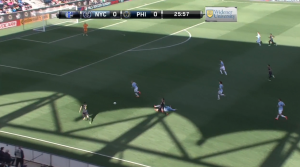
Andrew Wenger collected a loose ball and beat the defense up the field to start the break that led to the Union’s opener.
An effective Andrew Wenger instantly makes Philadelphia a dangerous team. Look no further than Eric Ayuk to see how involving the wing players forces a defense to spread out and give Nogueira and Pfeffer (or Maidana) the extra second they need to pick out the best release valve.
Wenger was better against New York, but he needs to do more. Jim Curtin talked a lot on Tuesday about how Michael Lahoud needs to grab his starting chance and keep it. Wenger appeared to do that last year, but he has not shown that same fire in 2015.
In the middle
Zach Pfeffer is no Cristian Maidana, that much is clear. However, Pfeffer’s late runs into the box did a lot to create space in the midfield and ensure that the Union counterattack had teeth.
To be sure, the young midfielder’s on-the-ball decision-making will and should be questioned. Again, Maidana has set a high standard for controlling the pace of a game and Pfeffer has not come close to replicating the Argentine’s efficient performances.
But Philadelphia has rarely featured a midfielder that can streak into the box as consistently as Pfeffer, and it put a lot of pressure on the New York back line and midfield to track those late runs. Young attacking midfielders are often too eager to get forward, and Pfeffer is no different. But on a team that should be advancing the ball up the wings and has struggled mightily connecting crosses, having an extra body in the box is the best return Philly can get when the creativity of Maidana is unavailable.
Lineup questions
It is unclear if Maidana will be ready to start on Thursday, and the Argentine has been plagued by minor injuries since arriving in Philadelphia. In Pfeffer, the Union have a suitable backup for their playmaker.
The same cannot be said of Maurice Edu and his tight hamstring. Ethan White is the likely replacement but his performances this season have not offered the same optimism that Pfeffer’s have. If White returns to the lineup, look for the Union to play a more conservative game, with Lahoud shading even further left to protect against Villa.
Conclusion: NYC 1-3 Union
Diskerud is out and New York is not stocked in the middle of the pitch. Provided the Union can adjust to NYC overloading the left channel, they should be able to stifle the home side’s attack and counter through the space left by the absence of a true defensive midfielder.
Last year, the Union peaked with two straight wins over a struggling Toronto side. Now they need to pull the same trick against another indifferent Eastern Conference opponent to jumpstart the 2015 season.
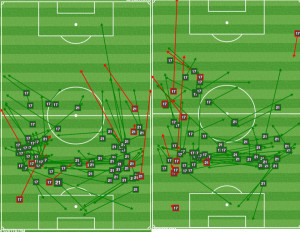
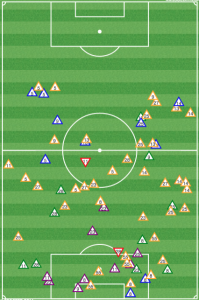
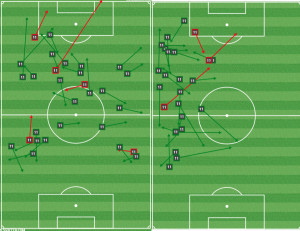
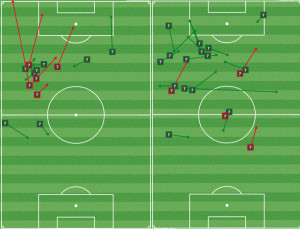
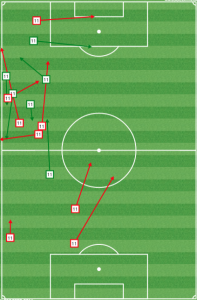
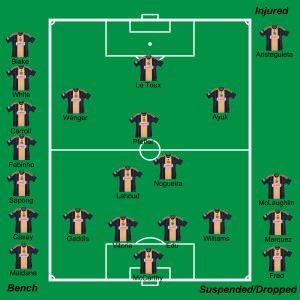
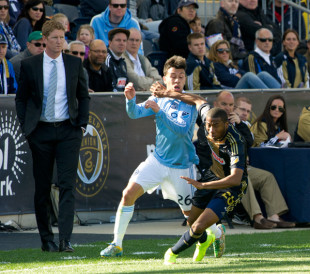

I was at NYCFC – NE earlier this season. That pitch is painfully small and makes for some ugly play. The dimensions force the squad to play a sort of keep-away training exercise rather than methodically looking for space (there is none). It’s really anyone’s game up there. The Man City Sheikh needs to build them a stadium as soon as possible. First touches and second balls will win this game. The tired legs and less than A-squads will keep it interesting. I offer no opinion on this outcome, but I think the U have a slight leg-up.
“First touches will win this game.”
Then we lost.
Funny, that keep away is exactly the kind of game I enjoy watching. The best clubs really just play SSG all over the pitch.
.
We haven’t quite figured that out for sure, but one way to nullify that quickness of thought is physicality. Knowing JC, which I don’t –but have a sinking suspicion anyway, he will send a message pregame of slowing play down as much as possible. To me that is more of an indictment of the players than the pitch though.
.
If ManCity West choses to build a small ass field I would have no problem with it — just not Yankee Stadium.
Lahoud -> Nogueira-> Maidana. I can see these guys putting together some nice triangles in the midfield in tight spaces. Lahoud is increasingly become a very tidy player. Perhaps learning a bit from Nogs.
I believe Fabinho is listed as “out” on the injury report. So slide McLaughlin into his bench spot, and cross your fingers that you don’t need Mike Lahoud to fill in at fullback in the event of an injury.
I would much rather see Sapong have a shot at a start than Le Toux. I haven’t see a game in NY yet, but if the pitch is that small, Le Touxs “run and run only” style will be even less effective. We need a little bit more physicality up top. Let Le Toux come in late to hassle and burn tired legs.
That’s a good point. It’s also a good opportunity for some rotation. Start Sapong, sub in Le Toux if you need his skill set late, or make another sub for Sapong as needed. That – hopefully – keeps both fresher for Sunday.
+1
I also got a “You are posting comments too quickly. Slow down.”
+1
I would just like to give a shout out to the person named Kermit Quisenberry. From any angle you view it, he would be a silent whistleblower.
.
It does not get any better than that name.
Can Pfeffer or Ayuk play left wing?
Might be a pretty dynamic mix if you had Sapong up top, combining with Ayuk, Maidana and Pfeffer, with Nogs just behind them.
Love these analyses Adam. Very well done – so appreciate the analytical breakdown for those of us who are tactically challenged!
If Nando is out I really would like to see Sapong up front. Perfect opportunity with a midweek game and another on Sunday. If he can’t go all 90 Casey is a perfect sub.
Not having Edu scares me especially with the nervous feet of McCarthy in net. Thinking this might be a high scoring affar…..
Intriguing that Kreis chose to overload the left side with his adjustments. On the positive hand, it plays to the preferences of his scorer, Villa. On the other hand, when Villa had switched to right side later in the first half and Vitoria/Gaddis were under direct immediate attack, I had the sense NYC was getting somewhere more effectively than they had when concentrating down their left earlier. Victoria’s pace and Gaddis’s “less-certain-under-pressure-than-Williams-feet” were exposed. Ludendorff did quite well in the spring of 1918 on the Western Front by maximizing pressure on enemy weaknesses.
.
We’re I Kreis, I would make a sustained effort against the Vitoria-Gaddis sector of the defense.